Saturday, 1 December 2012: Auckland: fish market and nature trail
On Saturday, no one had to go to work or to school, so we all breakfasted together and set off on our adventures of the day in both cars. We started by loading the back of Angie's car with a couple of large coolers (called "chilly bins" here) and allocating riders to vehicles. Everyone wanted to talk to everyone else, of course, and the kids were torn between their desire to ride together (so as to continue whatever game they were in the middle of) and the chance for the undivided attention of one or the other exotic foreign visitor, so rotated through patterns like the girls' car and the boys' car and the same but with the kids switched.
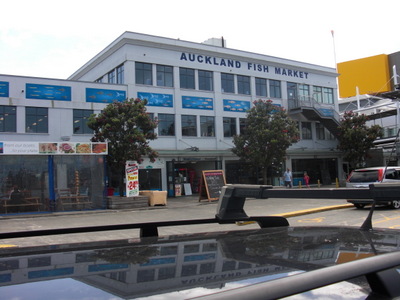
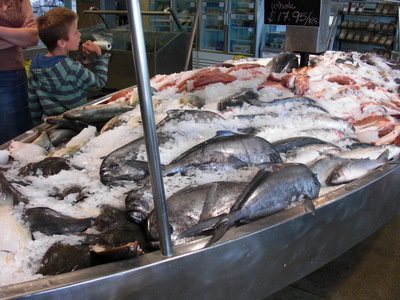 Our first stop was the Auckland fish market (not altogether coincidentally, right next to the Live Seafood Restaurant), where I got straight a lot of the names and species Kay had mentioned in the course of our stay. David, not a fan of fish markets, made a bee-line for the adjoining café and settled in with a cup of tea.
Our first stop was the Auckland fish market (not altogether coincidentally, right next to the Live Seafood Restaurant), where I got straight a lot of the names and species Kay had mentioned in the course of our stay. David, not a fan of fish markets, made a bee-line for the adjoining café and settled in with a cup of tea.
The right-hand photo shows "Ray's bream" (Brama brama, the "Atlantic pomfret"?). Just to their left, you can see a heap of some sort of small flatfish. We hadn't gotten a very good start, so we were rather late by fish-market standards, but I saw only a few areas of bare ice on the various tables.
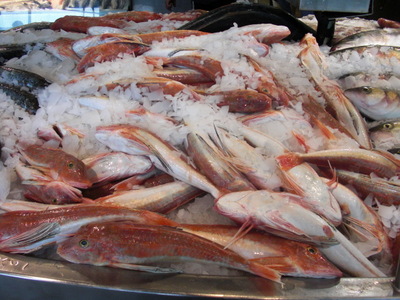
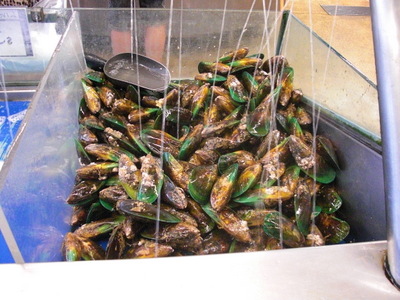 Just to the right of the Ray's bream was this pile of bright reddish gurnards (Chelidonichthys kumu), each about a foot long. On a separate stand were three tanks of live 5-inch-long green-lipped mussels. (A button above the tank briefly stopped the spray of water over them so that they could be conveniently scooped out into a sack, but we waited and bought ours later at a supermarket, where they were actually a good deal cheaper.
Just to the right of the Ray's bream was this pile of bright reddish gurnards (Chelidonichthys kumu), each about a foot long. On a separate stand were three tanks of live 5-inch-long green-lipped mussels. (A button above the tank briefly stopped the spray of water over them so that they could be conveniently scooped out into a sack, but we waited and bought ours later at a supermarket, where they were actually a good deal cheaper.
Among the species on display were spiny lobsters, paddle crabs (Ovalipes catharus), a tank of large live eels, barracuda, trevalley (a jack, probably either Caranx hippos or Pseudocaranx dentex), hapuka, kahawai (Arripis trutta, called "Australian salmon" but not actually a salmonid), what New Zealanders call "snapper" (Pagrus aurata, silver head seabream), John Dory (Zeus faber), little herring-like things, small catfish, several flatfishes, many species that weren't individually labeled, foot-long squid, sea urchins, several sizes of prawns, and a large bin of fresh scallops (with the roe attached, of course).
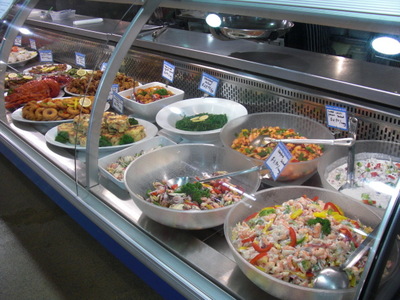
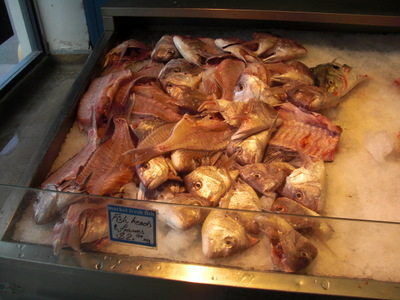 Over in the non-fresh-fish side of the establishment (where David lurked) was this deli case of prepared seafood dishes (only about half of which are shown here). The other side of the deli presented a very wide array of smoked seafoods. Just by the exit door was this assortment of inexpensive fish "heads and frames," left over from the preparation of filets, for use in soups and stews.
Over in the non-fresh-fish side of the establishment (where David lurked) was this deli case of prepared seafood dishes (only about half of which are shown here). The other side of the deli presented a very wide array of smoked seafoods. Just by the exit door was this assortment of inexpensive fish "heads and frames," left over from the preparation of filets, for use in soups and stews.
In the end, Kay and Angie selected a good-sized kingfish (Seriola lalandi, called yellowtail amberjack or great amberjack in the U.S.) and had it cut into steaks to grill for the evening's meal.
At this point, the seafood safely stowed in the "chilly bins," we rearranged passengers. Kay and the kids set off for the Villa Maria wine sale in search of barrels while Angie, David, and I drove to the top of Mount Eden (one of the city's many volcanic cones) for the 360-degree view of the city and surrounding volcanoes.
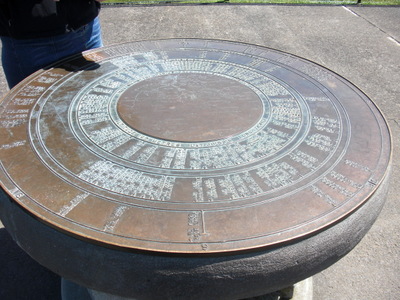
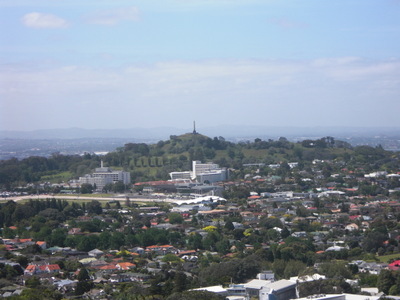 At the highest point is a benchmark surmounted by a simple, openwork navigational tower (welcome swallows were nesting under its conical roof, about 10 feet over our heads). Nearby is this wonderful bronze orientation table. The center is a relief map (unfortunately badly worn) of the area within 8 km of Mount Eden. The inner rings point to features a little farther away but many of which you can actually see, like the Auckland airport, and the successively wider circles indicate the directions and distances to more distant places (like Wellington, 462 km; Adelaide, Australia, 2804 km, Scott Base, 4570 km; Johanesburg, 12,183 km, and New York, 14,197 km).
At the highest point is a benchmark surmounted by a simple, openwork navigational tower (welcome swallows were nesting under its conical roof, about 10 feet over our heads). Nearby is this wonderful bronze orientation table. The center is a relief map (unfortunately badly worn) of the area within 8 km of Mount Eden. The inner rings point to features a little farther away but many of which you can actually see, like the Auckland airport, and the successively wider circles indicate the directions and distances to more distant places (like Wellington, 462 km; Adelaide, Australia, 2804 km, Scott Base, 4570 km; Johanesburg, 12,183 km, and New York, 14,197 km).
Looking away from the center of Auckland, I got this shot (slightly telephotoed) of what Angie thinks is One-Tree Hill, surmounted by a monument (or antenna?)—apparently the one tree is long gone.

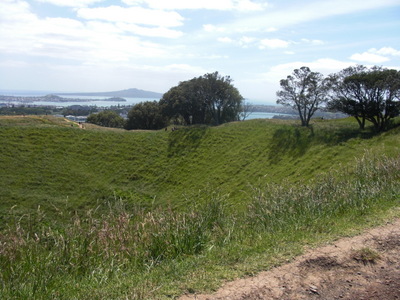 Facing the other way, the left-hand photo shows downtown Auckland, with it's famous "space needle" style tower. (You can also go to the top of that for the view, but Angie says it's not as good as that from Mount Eden.) The right-hand photo (looking a few degrees to the right of the other) shows Rangitoto, the most famous of Auckland's volcanoes (principally because it was the most recent to erupt).
Facing the other way, the left-hand photo shows downtown Auckland, with it's famous "space needle" style tower. (You can also go to the top of that for the view, but Angie says it's not as good as that from Mount Eden.) The right-hand photo (looking a few degrees to the right of the other) shows Rangitoto, the most famous of Auckland's volcanoes (principally because it was the most recent to erupt).
In the forgrounds of both photos are slopes down into Mount Eden's volcanic crater (now evenly covered with grass and wildflowers, all the way to the bottom). One is no longer allowed to go down into the crater, but we walked the trail around its rim (visible in both photos). Along the way, I spotted a black-and-white Australian magpie (different from but related to the European and American magpies, I think).
After a quick stop at the supermarket to pick up the mussels for the evening's appetizer, we rendezvoused with Kay and the kids at the German Christmas market in Green Bay (Kay is German and Angie Austrian, and of course they assure us that the market is not a patch on a real Christmas market), but it was apparently much smaller than last year's, and (much to Angie's disappointment) they ran out of food just as we got there, when Kay was about five people from the front of the line for German-style sausage on a bun. So, it was back to the house for a late salad lunch (dessert was honey nut gingerbread from the German market). This must have been the big weekend for festivals and fêtes, as we passed several others, including a Gypsy festival featuring a circle of assertively quaint and festive wagons.
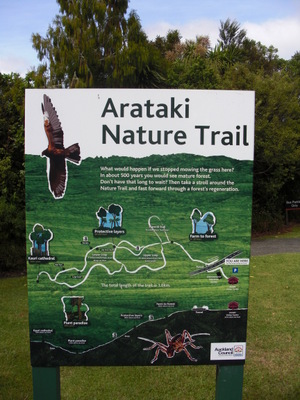
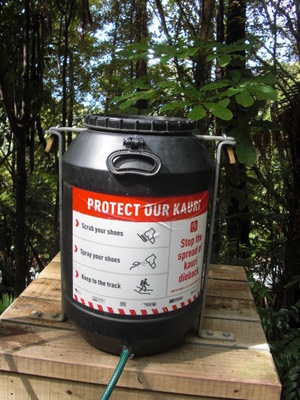 In the afternoon, we went back to the Arataki welcome center, under better weather conditions than the first time. David waited in the building with his Kindle (until they threw him out at closing time), while Kay and I walked the shorter of the the nature trails (about an hour).
In the afternoon, we went back to the Arataki welcome center, under better weather conditions than the first time. David waited in the building with his Kindle (until they threw him out at closing time), while Kay and I walked the shorter of the the nature trails (about an hour).
At the trail head, each hiker must scrub his shoes on special brushes set in a grid over a shallow pit, then spray the soles with this apparatus. These precautions are designed to stop the spread of a "fungus-like" dieback disease that is killing off New Zealand's emblematic kauri trees.
Near the beginning of the trail is a short optional loop very dense with plant labels, so that you can get some of the names and the appearances of the foliage in your head before seeing the rest of the route.

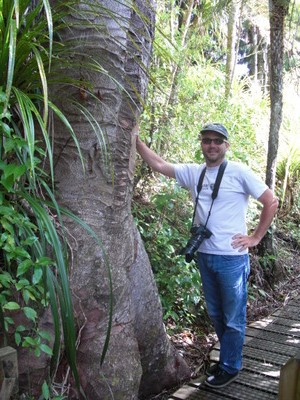 The kauris were spectacular, but for my money the most impressive tree on the circuit was this magnificent (New Zealand) white pine (kahikatea, Dacrycarpus dacrydioides, a podocarp; not at all like the North American white pine). Of course, the photo doesn't capture its majesty; really big trees are always difficult to portray. It and the several large kauris we saw were clearly much bigger than the surrounding vegetation, which is all second growth, and must be relicts from the era before the area was cut over and made into a potato farm. Strange to think of 10-foot tree ferns as second growth!
The kauris were spectacular, but for my money the most impressive tree on the circuit was this magnificent (New Zealand) white pine (kahikatea, Dacrycarpus dacrydioides, a podocarp; not at all like the North American white pine). Of course, the photo doesn't capture its majesty; really big trees are always difficult to portray. It and the several large kauris we saw were clearly much bigger than the surrounding vegetation, which is all second growth, and must be relicts from the era before the area was cut over and made into a potato farm. Strange to think of 10-foot tree ferns as second growth!
The tree Kay is leaning on was labeled as an example of a species that likes to growth with "wet feet," is low, boggy spots. Unfortunately, I don't seem to have photographed its label.
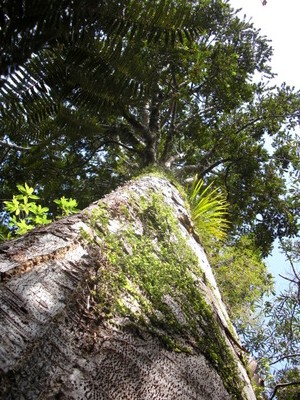
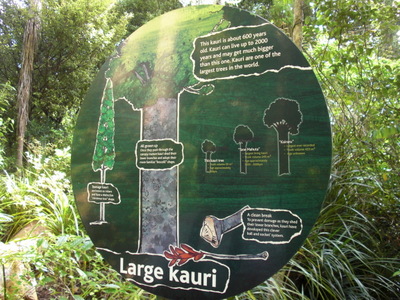 The trail includes several large (but not extremely large) kauri. This one, which I had to photograph facing almost straight up to get more than a couple of percent of it into the frame, is about 600 years old.
The trail includes several large (but not extremely large) kauri. This one, which I had to photograph facing almost straight up to get more than a couple of percent of it into the frame, is about 600 years old.
The right-hand photo shows the information panel about it. Kauri start out with the tall, narrow pyramidal shape shown at the left (Kay has several of these in his yard; they're protected, so even if he wanted to prune or remove them, he couldn't). At the right are three kauri silouettes, the smallest of which represents they tree we were standing next to. The middle one shows a 2000-year-old kauri, and the largest represents the largest individual kauri on record. No one knows how old it was, because the European colonists who cut it down didn't count the rings. One of the greatest bones of contention between the colornists and the Maoris was this destruction of individually named and revered kauri.
The whole nature trail was wonderful. At one point we were approached by a pair of fantails (Rhipidura fuliginosa), really cute and curious little birds that often approach and even follow walkers, cocking their wings and fanning their tails in a charming display behavior. Alas, they were too quick for me to photograph. At the end, of the trail, we found David sitting on the front porch of the visitors' center, still reading his Kindle.
For dinner, Angie made baked mussels topped with crumbs, oil, Parmesan, and parsley while Kay grilled the kingfish steaks. I made a sauce of a white roux, a little white wine, cream, stock from the kingfish head, lemon juice, salt, and parsley. Passion fruit ice cream for dessert.
.
previous entry
List of Entries
next entry

 Our first stop was the Auckland fish market (not altogether coincidentally, right next to the Live Seafood Restaurant), where I got straight a lot of the names and species Kay had mentioned in the course of our stay. David, not a fan of fish markets, made a bee-line for the adjoining café and settled in with a cup of tea.
Our first stop was the Auckland fish market (not altogether coincidentally, right next to the Live Seafood Restaurant), where I got straight a lot of the names and species Kay had mentioned in the course of our stay. David, not a fan of fish markets, made a bee-line for the adjoining café and settled in with a cup of tea.
 Just to the right of the Ray's bream was this pile of bright reddish gurnards (Chelidonichthys kumu), each about a foot long. On a separate stand were three tanks of live 5-inch-long green-lipped mussels. (A button above the tank briefly stopped the spray of water over them so that they could be conveniently scooped out into a sack, but we waited and bought ours later at a supermarket, where they were actually a good deal cheaper.
Just to the right of the Ray's bream was this pile of bright reddish gurnards (Chelidonichthys kumu), each about a foot long. On a separate stand were three tanks of live 5-inch-long green-lipped mussels. (A button above the tank briefly stopped the spray of water over them so that they could be conveniently scooped out into a sack, but we waited and bought ours later at a supermarket, where they were actually a good deal cheaper.
 Over in the non-fresh-fish side of the establishment (where David lurked) was this deli case of prepared seafood dishes (only about half of which are shown here). The other side of the deli presented a very wide array of smoked seafoods. Just by the exit door was this assortment of inexpensive fish "heads and frames," left over from the preparation of filets, for use in soups and stews.
Over in the non-fresh-fish side of the establishment (where David lurked) was this deli case of prepared seafood dishes (only about half of which are shown here). The other side of the deli presented a very wide array of smoked seafoods. Just by the exit door was this assortment of inexpensive fish "heads and frames," left over from the preparation of filets, for use in soups and stews.
 At the highest point is a benchmark surmounted by a simple, openwork navigational tower (welcome swallows were nesting under its conical roof, about 10 feet over our heads). Nearby is this wonderful bronze orientation table. The center is a relief map (unfortunately badly worn) of the area within 8 km of Mount Eden. The inner rings point to features a little farther away but many of which you can actually see, like the Auckland airport, and the successively wider circles indicate the directions and distances to more distant places (like Wellington, 462 km; Adelaide, Australia, 2804 km, Scott Base, 4570 km; Johanesburg, 12,183 km, and New York, 14,197 km).
At the highest point is a benchmark surmounted by a simple, openwork navigational tower (welcome swallows were nesting under its conical roof, about 10 feet over our heads). Nearby is this wonderful bronze orientation table. The center is a relief map (unfortunately badly worn) of the area within 8 km of Mount Eden. The inner rings point to features a little farther away but many of which you can actually see, like the Auckland airport, and the successively wider circles indicate the directions and distances to more distant places (like Wellington, 462 km; Adelaide, Australia, 2804 km, Scott Base, 4570 km; Johanesburg, 12,183 km, and New York, 14,197 km).
 Facing the other way, the left-hand photo shows downtown Auckland, with it's famous "space needle" style tower. (You can also go to the top of that for the view, but Angie says it's not as good as that from Mount Eden.) The right-hand photo (looking a few degrees to the right of the other) shows Rangitoto, the most famous of Auckland's volcanoes (principally because it was the most recent to erupt).
Facing the other way, the left-hand photo shows downtown Auckland, with it's famous "space needle" style tower. (You can also go to the top of that for the view, but Angie says it's not as good as that from Mount Eden.) The right-hand photo (looking a few degrees to the right of the other) shows Rangitoto, the most famous of Auckland's volcanoes (principally because it was the most recent to erupt).
 In the afternoon, we went back to the Arataki welcome center, under better weather conditions than the first time. David waited in the building with his Kindle (until they threw him out at closing time), while Kay and I walked the shorter of the the nature trails (about an hour).
In the afternoon, we went back to the Arataki welcome center, under better weather conditions than the first time. David waited in the building with his Kindle (until they threw him out at closing time), while Kay and I walked the shorter of the the nature trails (about an hour).
 The kauris were spectacular, but for my money the most impressive tree on the circuit was this magnificent (New Zealand) white pine (kahikatea, Dacrycarpus dacrydioides, a podocarp; not at all like the North American white pine). Of course, the photo doesn't capture its majesty; really big trees are always difficult to portray. It and the several large kauris we saw were clearly much bigger than the surrounding vegetation, which is all second growth, and must be relicts from the era before the area was cut over and made into a potato farm. Strange to think of 10-foot tree ferns as second growth!
The kauris were spectacular, but for my money the most impressive tree on the circuit was this magnificent (New Zealand) white pine (kahikatea, Dacrycarpus dacrydioides, a podocarp; not at all like the North American white pine). Of course, the photo doesn't capture its majesty; really big trees are always difficult to portray. It and the several large kauris we saw were clearly much bigger than the surrounding vegetation, which is all second growth, and must be relicts from the era before the area was cut over and made into a potato farm. Strange to think of 10-foot tree ferns as second growth! 
 The trail includes several large (but not extremely large) kauri. This one, which I had to photograph facing almost straight up to get more than a couple of percent of it into the frame, is about 600 years old.
The trail includes several large (but not extremely large) kauri. This one, which I had to photograph facing almost straight up to get more than a couple of percent of it into the frame, is about 600 years old.